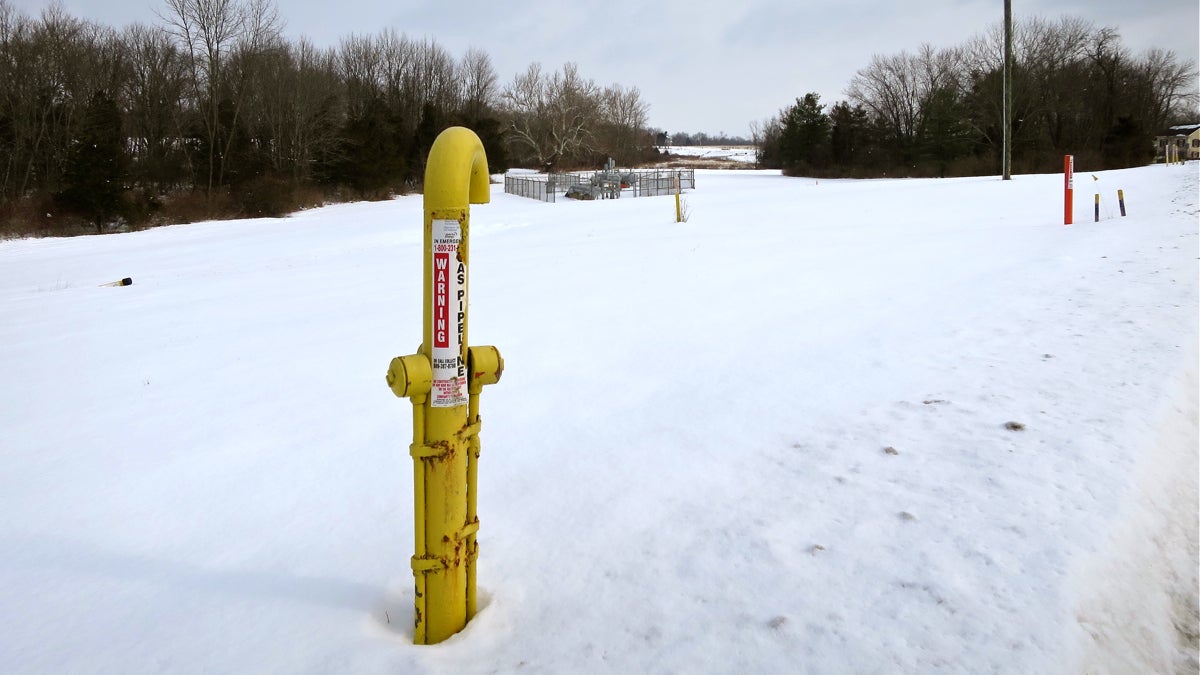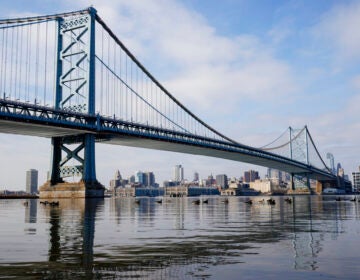Backers tout economic impact of 114-mile PennEast pipeline
Listen
A marker shows the path of the Texas Eastern Pipeline as it runs under a field in Lambertville, New Jersey. It is one of several natural gas pipelines buried under farms, forests, backyards and waterways in the region. (Katie Colaneri/WHYY)
A new study commissioned by the consortium of companies behind the PennEast pipeline finds it would generate $1.62 billion for the Pennsylvania and New Jersey economies during the project’s construction phase.
The study, conducted by Philadelphia-based Econsult Solutions and Drexel University’s LeBow College of Business, also projects design and construction of the pipeline would support 12,160 jobs generating about $740 million in wages. Econsult released a similar analysis last week, projecting $4.2 billion in economic benefits for Pennsylvania from the Mariner East pipeline project.
“PennEast is clearly an important player in an important chapter in a broader energy story taking place in the region,” said Drexel economics professor Vibhas Madan, one of the co-authors of the study.
A glut of natural gas production has led to a boom in new pipeline construction to move that gas to market.
However, most pipeline jobs are temporary.
“Most of the jobs associated with developing the pipeline will be relatively short run, and many of the workers, if not most of the workers involved, will not be local residents,” said Penn State economist Tim Kelsey. “So it’s not a local employment boost for the community.”
Once built, operation of the PennEast pipeline would support 98 jobs, including about 88 in Pennsylvania and 10 in New Jersey. Backers say the project, which awaits approval from numerous state and federal agencies, would come online in 2017. Click for the full report on the PennEast website.
Kelsey says those who benefit most from pipelines in the long run are customers who want cheaper gas and electricity, especially industrial businesses including factories and power plants.
PennEast officials plan to release a second study on the pipeline’s impact on consumers.
“It will support what partners have known all along that there is a compelling need for the PennEast project,” said Pete Terranova, chairman of the PennEast pipeline board of managers. He would not say not much the first study cost.
The 114-mile, 36-inch pipeline would deliver 1 billion cubic feet of natural gas a day and has met with strong opposition in the six counties, including Bucks, in Pennsylvania and New Jersey it would pass through.
Environmental groups leading opposition to the project dismissed the study.
In a press release, Delaware Riverkeeper Maya Van Rossum said the analysis was “designed to skew the perception of their damaging pipeline that will inflict major harm to the properties, natural lands, public lands, streams, wetlands and forests it passes through.”
The Federal Energy Regulatory Commission (FERC) will begin hearings on the pipeline Tuesday as it prepares to draft an environmental impact statement. Here’s the schedule:
Feb. 10 – Northampton Community College 3835 Green Pond Road, Bethlehem, Pa. 18020
Feb. 11 – Penn’s Peak 325 Maury Road, Jim Thorpe, Pa. 18229
Feb. 12 – Best Western Hotel & Conference Center 77 E. Market St., Wilkes-Barre, Pa. 18701
Feb. 25 – West Trenton Ballroom 40 W. Upper Ferry Road, West Trenton, New Jersey 08628
Feb. 26 – The Grand Colonial 86 Route 173 West, Hampton, New Jersey 08827
All scoping meetings will start at 6 p.m. Representatives from PennEast will be available for one hour before each meeting at 5 p.m.
This story comes from StateImpact Pennsylvania, a public media collaboration of WHYY and WITF covering the state’s energy economy.
WHYY is your source for fact-based, in-depth journalism and information. As a nonprofit organization, we rely on financial support from readers like you. Please give today.




